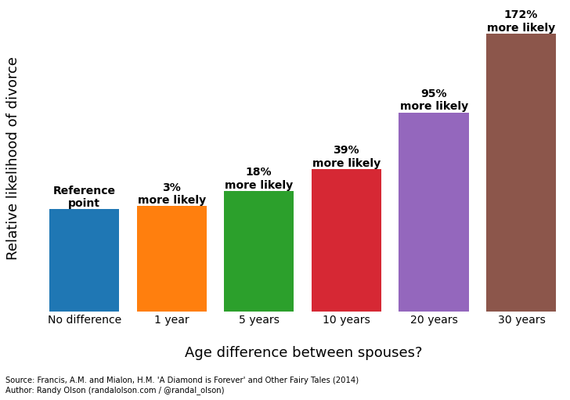Some Practical Marriage Advice: Get Hitched With Someone Your Own Age

The success of a marriage is a multifaceted monster that’s difficult to predict. Nearly a decade ago, the nation was shocked to find half of all total U.S. marriages ended in divorce, and finding the key to the perfect marriage came to the forefront of society. Data scientist Randy Olson was one of those curious individuals who set out to uncover and break down all of the marriage factors. Previously he found money, engagement ring and wedding price, children, dating length prior to engagement, but part two of his data set reveals age is one of the biggest predictors of a lasting marriage.

Age mates are least likely to divorce. The closer a couple is in birth age, the greater the change their marriage will last. Olson analyzed data from more than 3,000 recently married and divorced Americans and found success lies in the birthdays. Those who are the same age have the lowest chance, while those who are five years apart have an 18 percent higher chance of divorce. It doesn’t sound as threatening as couples with 20 years between them, who are 95 percent more likely to get divorced than age mates.
The reason age is such as reliable predictor is because with the difference comes differences in life experiences, stages, and generational cultures. A 25-year-old woman grew up with a completely different set of technological practices, social norms, fashion trends, and music and entertainment stars than a 50-year-old did.
But it’s difficult to take an age gap and throw the odds against you when there are so many other moving parts at play. For example, Olson also uncovered from his data that having a baby completely changes the outcome of a marriage. Having a child with your spouse decreases the chance of divorce by 76 percent. However, if you have your first child out of wedlock and then get married later on, you only have a 59 percent less likelihood of divorce.
It’s important while looking at data to understand the difference between correlation and causation. Correlations could mean a number of things when it comes to numbers. If having a child out of wedlock leads to divorce more often than those who are married during the birth, it could mean a number of things. Out of wedlock births could be less stable because of the child lying a foundation of stress for their marriage, or it could mean the instability is from marrying only because they had a child, or a long list of other reasons. Causation means one outcome was definitely caused by one factor.
If you and your husband or wife have an age gap, there’s no need to worry. Statistics aren’t crystal balls or guarantees; they’re merely correlations in this case. A 25-year-old could have the maturity and patience of a 50-year-old, or inversely, the 50-year-old could be stuck at the stage of their young companion. As long as they’re happy, right?
Wrong. Sometimes it costs too much to get a divorce, which may be why the divorce rate started to decrease once the economy crumbled in 2008. Take 84-year-old Rupert Murdoch’s marriage to 44-year-old Wendi Deng, for example. Not only did the 40-year age gap put them against the odds of success, but the divorce also cost $1.8 billion. Whomever said divorces are expensive wasn’t kidding.



























